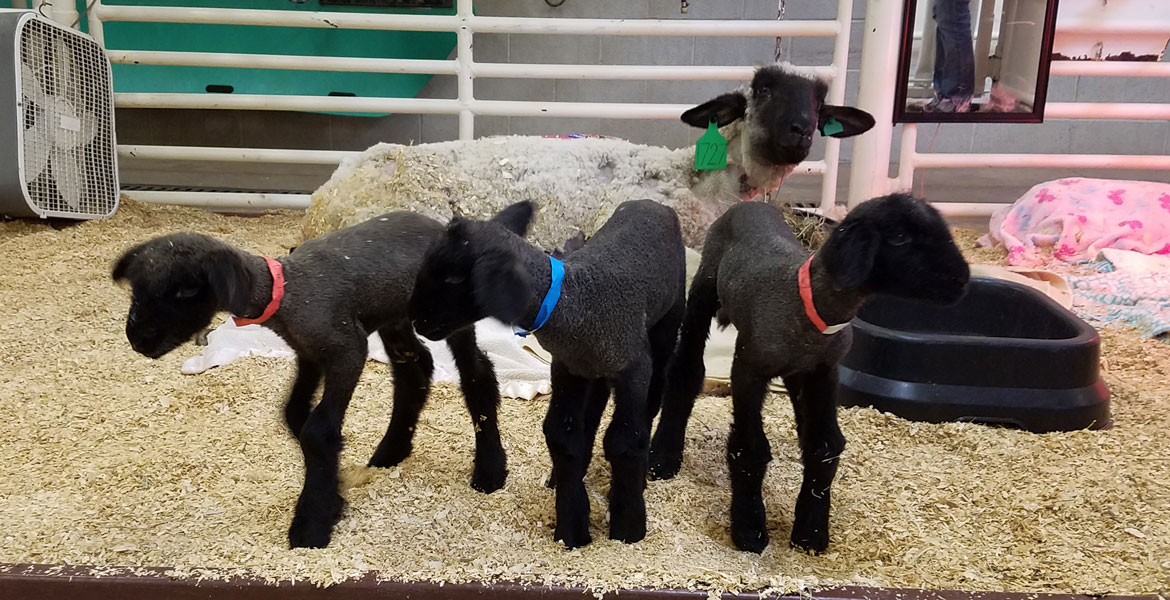
Treating Pregnancy Toxemia, a Major Disease of Sheep
Thursday, January 9, 2020
Dr. Megan Williams works as an assistant professor of equine surgery at Oklahoma State University College of Veterinary Medicine’s Veterinary Medical Hospital. In early January 2020, she brought one of her sheep in for treatment – a pregnant ewe of the Hampshire breed.
“My husband has had sheep his entire life and for as long as I have known him, we have had sheep,” said Williams. “Currently, we have about 40 pregnant ewes. All our sheep are bred on artificial insemination initially. This particular sheep was due to lamb soon with multiple babies. They have a hard time handling that at the end stages of pregnancy. She started to get weak and recumbent. We treated her the best we could out in the country with limited supplies and then brought her to the hospital where she could get more intensive care.”
“We diagnosed Dr. Williams’ ewe with pregnancy toxemia,” said Dr. Meredyth Jones, associate professor of food animal medicine and surgery at the veterinary hospital. “Pregnancy toxemia is a condition that we see in sheep and goats in late gestation – the last two to four weeks of pregnancy. When they are pregnant with multiple babies, as they often are, those babies start to grow almost exponentially towards the end of pregnancy taking a lot of nutrition away from their mom. In addition, as they grow, they take up more space. Mom needs more energy but eats less because there is less space. Basically, she just runs out of gas and is unable to support herself.”
According to Dr. Jones, pregnancy toxemia is one of the top three major diseases of sheep and goats treated at OSU’s Veterinary Medical Hospital.
“Unfortunately, pregnancy toxemia is fairly common in sheep and goats,” she said. “The main thing we do is provide them with more nutrition. We provide them with sugar through an IV to give them energy. We provide them with electrolytes and minerals like calcium that they tend to be low in. In this particular sheep, she needed a little extra help beyond that so we did a technique called partial parenteral nutrition, which is where we feed her through her IV. She actually received amino acids, which are the building blocks of protein, through her IV to support her more nutritionally.”
On January 9, 2020, the Williams’ ewe gave birth to three lambs.
“The lambs are doing great,” said Jones. “They had a difficult delivery so as you might expect, they got a slow start. The mom didn’t have enough energy to deliver them on her own so they needed some help coming into the world. They are taking their bottles and are very active—two girls and a boy. The ewe is able to stand with assistance now. We put her in a sling on wheels and she is able to propel herself. She is still weak but she’s coming along.”
“We were definitely pretty concerned about her the last several days leading up to her having the lambs,” said Williams. “She seems to be getting stronger and as long as she continues on the upward trend, she should be just fine. We’re very appreciative to Dr. Jones, Dr. Crabtree and Dr. Weaver. We’re excited that they are doing as well as they are.”
“Pregnancy toxemia is a condition that in most situations can be prevented,” added Jones. “Certainly we can’t always control how many babies the mom is going to have, so sometimes it sneaks up on producers. However, this is a condition that we would love the opportunity to educate producers about and let them know that we provide the service for its treatment. We can also help producers manage their herd and flock to try to prevent this from happening to the extent that is possible.”
For more information on pregnancy toxemia, please contact the food animal medicine and surgery service at Oklahoma State University College of Veterinary Medicine’s Veterinary Medical Hospital at 405-744-7000, ext. 2.
CONTACT: Taylor Bacon | Public Relations and Marketing Coordinator | 405-744-6728 | taylor.bacon@okstate.edu
